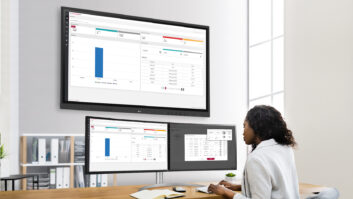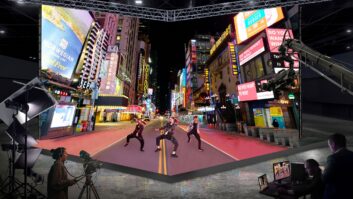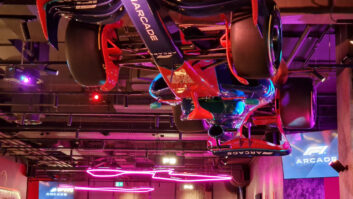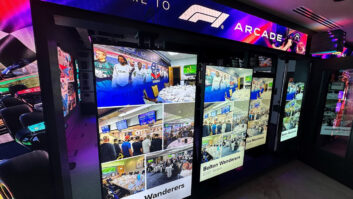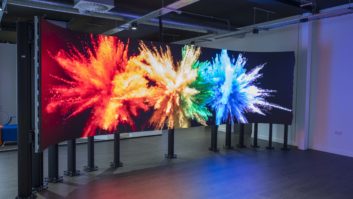
What are the primary issues impacting the global AV industry?
The consumer experience is a huge consideration. Our role in the manufacturing and channel communities is to create experiences that delight consumers in retail, hospitality, entertainment and even workplace environments. The extent of that delight is contingent on what consumers are generally used to experiencing. Their expectations are based on exposure to multichannel sound, 4K televisions and other CE technologies. Our challenge, therefore, is to up the ante on the ‘ordinary’ consumer experience and give them something extraordinary. We achieve this today with curved displays, LG OLED, LG OLED Wallpaper and transparent OLED – and we’ll achieve it in the future with new professional-grade technologies from our pipeline.
Within the industry, AV networking is the preeminent force of change. Advancing transport and controlling both devices and experiences elevates the power of systems while also facilitating exciting new business models for systems integrators and commercial customers alike.
AV/IT convergence is a natural segue from networked AV and it will continue to be a discussion point. I think some of the anxiety around convergence is misplaced. AV and IT can co-exist, even complement each other in advancing system performance, bandwidth optimisation and, more importantly, security.
At LG, and among our partner community, one of the most significant positives we’ve seen is the strength of the collaboration sector. It’s right there at the intersection of AV and IT, providing compelling value to end user businesses and expanding the universe for AV expertise and devices.
How are the products, solutions changing?
The solutions are becoming more purposeful and this is great for the systems integration business. Retail, hospitality and other businesses can no longer cut it by buying off-the-shelf consumer products with the hope of creating a professional-grade experience. They need integrators to create the experience and secure the system. This is a benefit for everyone and is stimulating the need for MRR models for monitoring and managing systems enabled by networked AV systems.
Just as AV and IT convergence advances, AV and IT roles will co-exist. IT will be responsible for the infrastructure, but AV will be responsible for the experience and this will naturally impact how integrators position and sell their services, organise their businesses, recruit and train their teams, and more.
Some of the key challenges for our industry include: how to position and promote the integrator function as the critical role in making an extraordinary experience come together; and how to ensure that experience continues to run uninterrupted. We ask these questions of ourselves at LG and we address the first question with curved displays, LG OLED, LG OLED Wallpaper and transparent OLED, and the second question with WebOS. It is our responsibility to provide the product solutions, however the industry still needs integrators on the ground to ensure an efficient and successful installation.
Are these changes impacting the basic structure of our industry; how products, solutions are sold and supported?
I believe so. This is most obvious when you look at collaboration technologies. There are many platforms and technologies that simply did not exist 10 years ago, but now collaboration tech is one of the strongest growth areas for AV solutions and services. It has effectively evolved from touch functionality to ecosystems comprising interactive whiteboards, PCs, videoconferencing and mobile devices. AV is the master of that experience and so the platforms have had a force-multiplier effect on the need for AV solutions, AV support and AV services.
Are the verticals experiencing change?
It really varies by region depending on government/state funding of education and public services, but across the board, corporate is very strong. Our displays are being deployed into a wide array of corporate applications from the lobby to the exterior of the building, interior rooms and the boardroom. We’re seeing a very wide range of uses within the corporate environment from videoconferencing to huddle rooms and collaboration suites. That’s very exciting.
Other compelling verticals are retail, restaurants, and QSRs (quick serve restaurants) and our displays are transforming those business environments, and arguably, those businesses.
“Our challenge is to up the ante on the ‘ordinary’ consumer experience and give them something extraordinary”
How is LG addressing these changes?
We work hard to stay ahead of change. We’re in very close co-operation with the channel and end user communities, but also with influencers like architects, designers and even regulators to make sure we’re engineering solutions which businesses can use to serve their customers. A good example is our transparent and curved LG OLED displays that integrators specify to retailers, enabling the retailer to create an experience that rivals that of online retailers.
I can point to similar examples of customer/integrator-inspired LG technologies that enable integrators to provide business-critical value to their customers in hospitality, corporate, healthcare and education. It’s exciting and rewarding to be a part of these professional collaborations.
What is LG’s strategy on innovation?
LG is all about purposeful innovation. Consider LG OLED technology – best-in-class viewing angle, perfect black, category-leading colour and phenomenal design – we’re deliberate and detailed about understanding how the technology will be deployed, installed, used and maintained in all of the various verticals we serve. We’re determined to deliver the right tools to ensure integrators and end-users are successful today and in the future.
Our innovation strategy begins in the marketplace with the integrators (business owners, managers and installers) and the end users in the verticals. We inform it with experience from other markets — for instance IT into AV — and we also apply pure research to every challenge, but we start off thinking about the worker on the job and we explore ways to make their job easier. We speak to the people who program software in the back office, and once we become aware of the pain points, that’s the impetus for purposeful innovation.
What do you think will be the major stories from InfoComm this year?
I think the realisation that AV has turned a corner and that we’re now part of a larger ecosystem with other technologies from the IT, life safety, security, AI and automation domains. Our role is increasingly well-defined as the manufacturer brands, and systems integrators who deliver the experience. Others have their roles, but we’re responsible for delivering delight while also respecting the infrastructure and security concerns of others at the table. That realisation is a major step forward for our industry.
What will LG be emphasising at the show?
Our message at InfoComm will focus on the critical importance of professional-grade display devices that are high-performing, reliable and deliver a delightful experience. Case in point, our transparent OLED that enables systems integrators to engineer impactful experiences in retail, hospitality, healthcare and corporate environments. The combined impact of stunning displays and clever, creative content is transformative in stores, hotels and restaurants, clinics and corporate lobbies.
If you consider the potential of transparent LG OLED to do exactly this, the possibilities are endless. With LG OLED and our transparent LED film, integrators can look at new surfaces within the built environment and can take virtually any piece of glass and make it a display.
How do you think the global AV systems integration community can sustain strong relevance and deliver value in the years ahead?
As an industry and a community, we need a collective appreciation of the value chain and our respective roles as manufacturers, systems integrators and consultants, etc. We need to know and understand the adjacent participants in the value chain and, based on that information, create a broader, stronger understanding of the value – and the chain.
Where do you think the strongest opportunities lie?
I think if you look at the global business and how we’ve all made systems more affordable, easier to deploy and use and more impressive and delightful, there is considerable opportunity for growth. But this growth requires an acknowledgement that this is a B2B market and not one of box-stuffers, prosumers and commodities. Our brands – that of LG and other manufacturers, but also of AVIXA and the systems integration firms – need to have meaning, and that goes back to the value chain.
The opportunity is there for the taking. We just need to be bold and grasp it.


